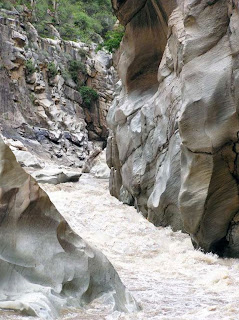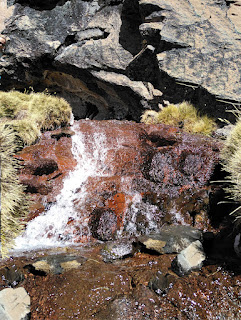When reading the various theories of Lehi’s landing site and the home of the Nephites for a thousand years, most theorists have a list of items they feel need to be met for a Land of Promise location to be determined. These lists vary from five or six to ten or twelve—but many, if not most of these lists contain items that are either not in the scriptural record, mis-interpreted or mis-understood by the theorist(s), or inadequately addressed or do not demonstrate what the theorist(s) think they do, or is not evident from what Mormon or the others say, or that reason suggests they are being mis-used. In fact, most items on these lists are not listed with the scriptural reference given us by Mormon, Nephi, Jacob, or Moroni. As an example:
Sorenson’s map of his Land of Promise where Mormon’s “west” is Sorenson’s “North” and Mormon’s “South” is Sorenson’s “East”
1. John L. Sorenson trying to show why Mormon did not use the cardinal directions we know, but a different understanding of directions he claims were known to the Hebrews, but does not show a scriptural reference to support his conclusion of using west instead of north and east instead of south n both land and sea locations;
2. Some theorists’ list includes a record of writing in post Nephi times that show the Nephi writing is still being used—unrelated to the geography but important to some modelers is current evidence of ancient writing, which they claim there are only two regions in the Americas showing the high degree of ancient civilization required by the text of the Book of Mormon.
One of these locations is centered in South America in the region once occupied by the Inca civilization. The other is centered in Mesoamerica in the region once occupied by the Maya and the Olmec civilizations. They claim that of the two, only the civilizations in the Mesoamerican region are known to have had a sophisticated form of writing (Michael D. Coe, The Maya 6th ed., Thames & Hudson, New York, 2002, p13).
While that is the opinion of the Mesoamerican theorist(s), it is not accurate—there are several examples of ancient writing found in Andean Peru that is at least on a par with Mesoamerica. The difference is that it was not used by the Inca—whose accredited talents and achievements were not accomplished by them, but by an earlier civilization. Regarding post-Nephite writing, Rongorongo writing of Easter Island that was transported there from Peru, has defied interpretation and translation by numerous linguists who have made the attempt;
Two different Narrow Necks of Land on one Heartland map
3. Some lists show that their Narrow Neck of Land is the Niagara Peninsula, which runs east and west (not north and south as Mormon describes)—others claim there are as many as five narrow necks and narrow passes scattered over their models, one being between the Black Swamp of Lake Erie and the Grand Kankakee River marsh and Lake Michigan;
4. Mesoamericanists list the Narrow Neck of Land running east and west—their Isthmus of Tehuantepec—at between 130 and 144 miles in width—obviously, not possible for a Nephite to cross in a day-and-a-half;
5. Heartlanders use modern-day prophecies, statements, and even opinions, rather than rely initially on a scriptural Book of Mormon reference and state it as such. As an example, of the 32 statements in the Appendix of Porter and Meldrum’s book Promises and Prophecies, only 3 are referenced to the Book of Mormon—15 are newspaper articles, 3 are letters, and 4 are articles in various formats;
6. Mesoamericanists claim that the limited geography models are the result of the text of the Book of Mormon—and to be realistically interpreted as an historical document, the events described must be limited to an area of several hundred square miles (Bruce H. Porter and Rod L. Meldrum, Prophecies and Promises: The Book of Mormon and the United States of America, Digital Legend Press and Publishing, New York, 2009, p13);
7. Mesoamericanists and Heartland models have very different climates. First, Mesoamericanists associate climate only with the warmth of the Land of Promise and the wearing of loincloths; however, what is far more important about climate is the growing of seeds brought from Jerusalem which they planted in the location of Lehi’s landing.
In 600 BC, seeds grew well only in the same climate as that in which they were developed, and since Jerusalem has a Mediterranean Climate, Lehi had to have landed in an area with a Mediterranean Climate for his seeds to have grown exceedingly and produced an abundant crop (1 Nephi 18:24).
Example of the Köppen-Geiger-Pohl Climate Classification. Over many years, they have succeeded in mapping the entire world in their very popular climate categories
Jerusalem’s Köppen-Geiger-Pohl Climate Classification is Csa or Csb—dry summer climate characterized by dry summers and mild, wet winters (The difference is Csa: hot, dry summers or Csb: cool, dry summers). However, Mesoamerica’s Köppen-Geiger-Pohl Climate Classification is Cwb—Oceanic Subtropical Highland Climate, and also Aw—Tropical Savanna Climate, neither of which would have provided a growing climate for Lehi’s seeds “brought from Jerusalem, which is a dry summer climate is characterized by dry summers and mild, wet winters
Secondly, Heartland theorists claim they have a similar climate with that of Jerusalem since they are on the nearly same latitude—Jerusalem is 31.7º north Latitude; Apalachicola, Florida is 28.7º Latitude; and 30.4º for Tallahassee, Florida; while Crystal River, Florida is 28.9.
The problem with this is that Mediterranean Climates outside of the Mediterranean basin are found along the western coasts, not the eastern or southern coasts in the southeast United States.
The climate classification for Apalachicola, Florida, is Cfa, “humid subtropical,” with short, mild winters and hot, humid summers. In addition, the proposed landing site of Lehi at Crystal River, Florida, also has a Cfa classification, “Humid subtropical climate,” and found on the eastern sides of the continents between 20º and 35º N and S latitude; besides, there is significant rainfall throughout the year in Crystal River—even the driest month still has a lot of rainfall.
Other than the Mediterranean Sea area itself, all Mediterranean Climates are located on the western coastal area of continents
On the other hand, in South America, Coquimbo and La Serena, Chile, are on the western coast of the continent at 30º south latitude in South America, and have a Mediterranean Climate. As Nephi said of their landing site: “we did put all our seeds into the earth, which we had brought from the land of Jerusalem. And it came to pass that they did grow exceedingly; wherefore, we were blessed in abundance” (1 Nephi 18:24).
8. Metallurgy (Ether 10:7,27), gold and silver (1 Nephi 18:25; Helaman 6:9), did not exist in the Heartland and Great Lakes during Jaredite or Nephite times. While there was plenty of copper in the Great Lakes area, and very limited scattering of gold and silver east of the Rocky Mountains, full metallurgy as described in the scriptural record was unknown. In Mesoamerica, metallurgy of any kind was not known until sometime between 600 and 900 AD.
However, Andean Peru was known for its full metallurgy from the Jaredite period onward without interruption. To show the extensiveness of these ores in Andean South America, today Chile and Peru are world leaders in copper, gold and silver reserves and world exports of these precious metals .
(See the next post for more information and comparing of the three popular theories against Andean South America)

























